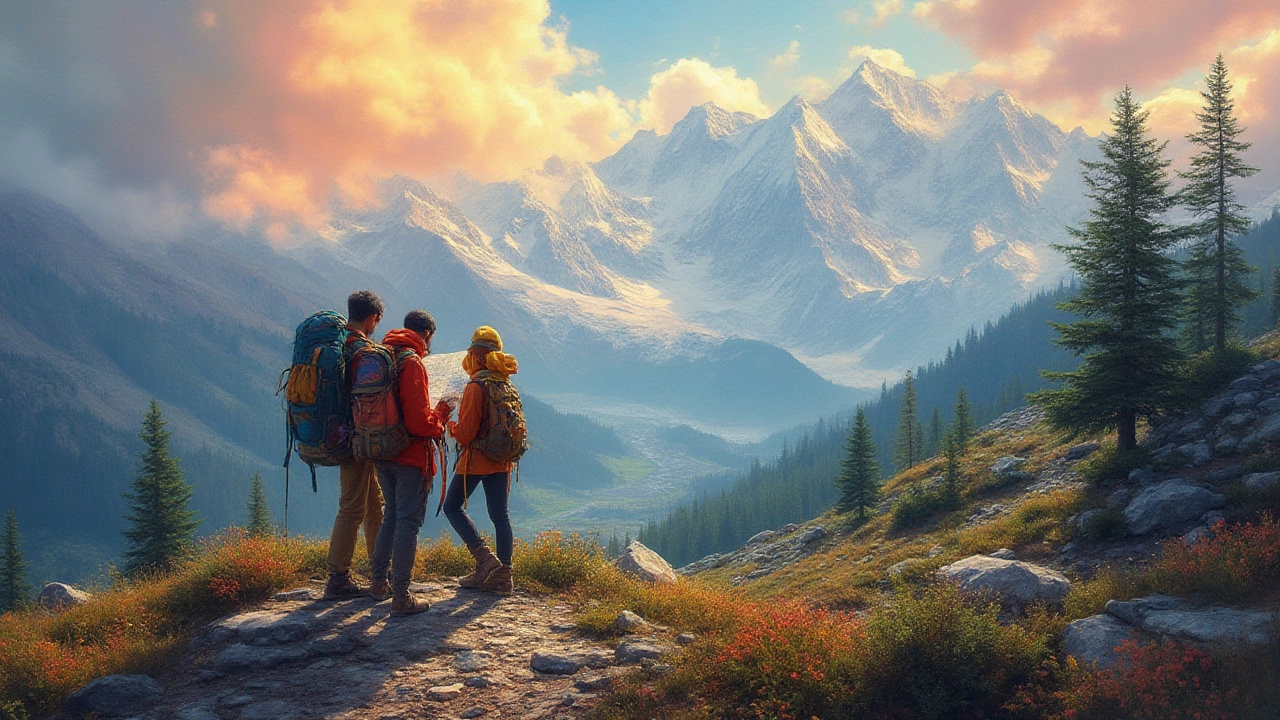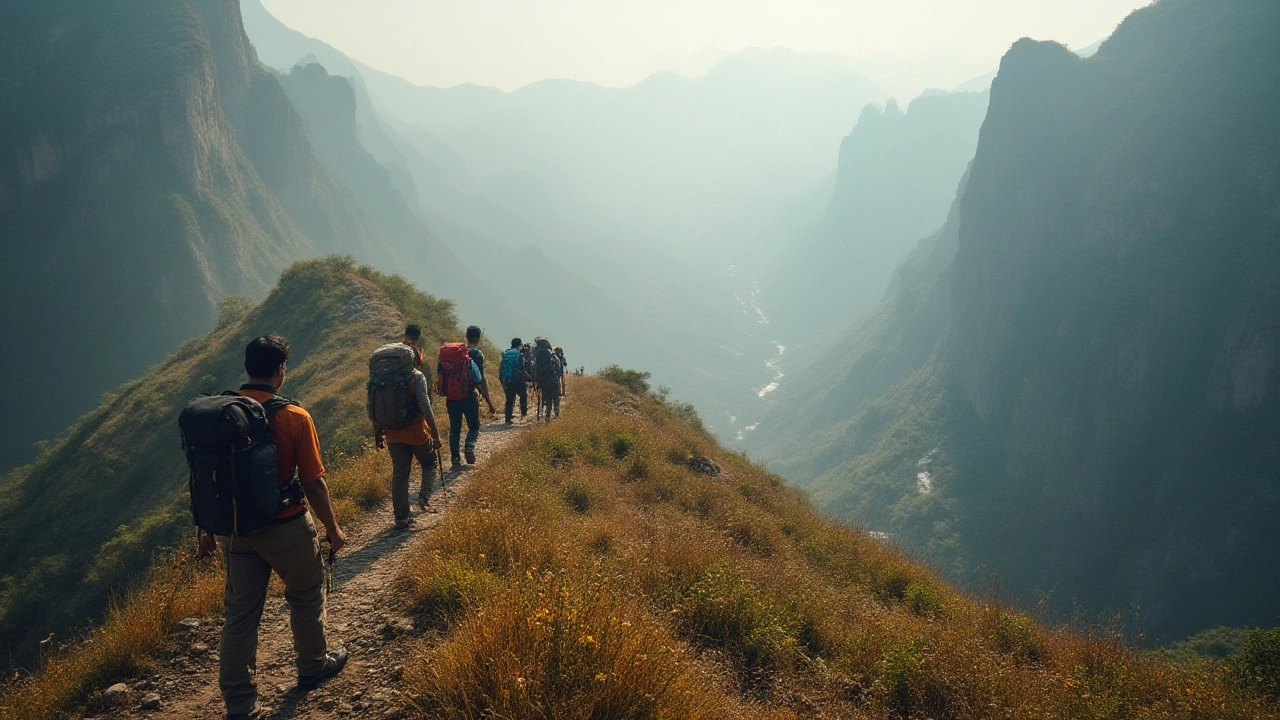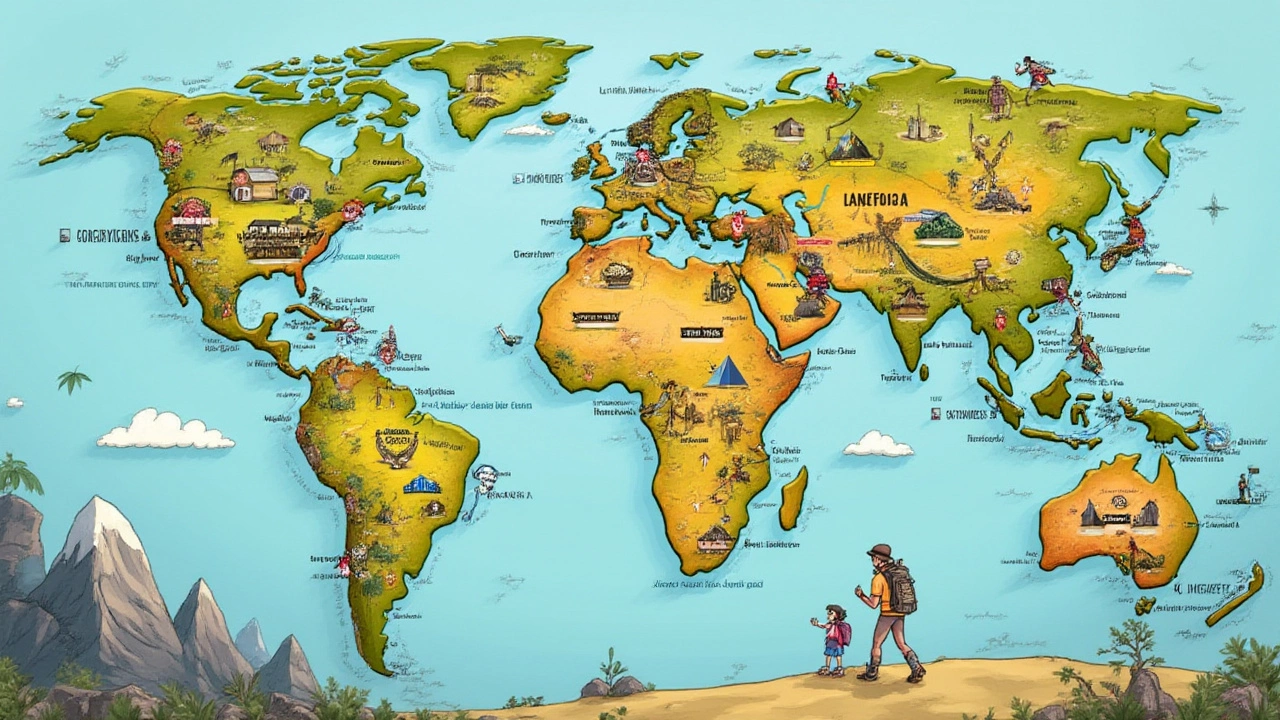Top Countries for Trekking: Ultimate Guide to the Best Trekking Destinations Worldwide

- Jul, 15 2025
- 0 Comments
- Aaron Blackwood
You know that feeling when your boots hit the dirt and the world just opens up? Not all countries are equal when it comes to trekking, and the differences can be huge. Some places offer wild landscapes where you won’t see another soul for days, while others throw you into a teeming circus of like-minded trekkers from every corner of the planet. So which country is the king of trekking? Picking the best isn’t just about who’s got the tallest mountain—it’s about experience, scenery, people you meet on trail, accessibility, and which place fires up your adventure itch the most.
Trekking Heavyweights: Countries Where Hiking Rules
Start with Nepal—because no list about trekking is real without it. The country practically invented trekking as an idea, not just as a thing you do. The Himalayas, home to the mighty Everest and Annapurna ranges, are packed with routes where village guesthouses serve hot tea and apple pie at high altitude. Annapurna Circuit is probably the most famous multiday trek, winding through landscapes so dramatic you might pinch yourself just to make sure you’re awake. Then there’s Everest Base Camp, which is more than just a route to a mountain; it’s a pilgrimage, a shared struggle with hikers from every continent. Fun fact: by 2025, Nepal’s trekking permits were up 40% from a decade ago, making it more popular now than ever before.
Switch gears to Peru, where the classic Inca Trail winds right up to Machu Picchu’s Sun Gate. Trekking here is more than mountains—it’s walking in the footsteps of an empire. Lately, the Salkantay Trek has blown up in popularity for offering similar drama without the permit hassle. Local guides know every inch of trail, and the campsites often sit under wild Andean skies. The Sacred Valley is a place where llamas come free with the scenery, and where high mountain passes test your lungs. Tip: trail permits for the Inca Trail are snapped up months ahead, so book early or aim for an alternate trek like Lares or Choquequirao.
Now let’s talk about New Zealand. If you love variety, the so-called "Great Walks" offer everything from volcanic desert on the Tongariro Alpine Crossing to wild fjords on the Milford Track. Here, trekking—Kiwis call it tramping—is a lifestyle, and trail huts are legendary for their camaraderie and stories. Milford Track, often named the finest walk in the world, sells out quickly, and with good reason: think waterfalls, ancient forests, and mountains glowing in the soft southern light. You’ll learn very fast that the weather here makes its own rules—always pack rain gear, even when the sun’s out. Kiwi trails are marked and mapped so well that anyone with basic fitness and prep can tackle a world-class route.
You can’t skip Switzerland and its vast alpine network. Every village, it seems, is linked by a series of well-marked trails, so you’re never far from a bakery or a train station. Hiking here spoils you forever—wildflower meadows, glaciers glinting in the sun, cows with bells, and paths that look impossible but are tamed by centuries of use. The Tour du Mont Blanc dips across borders, Swiss huts serve Rösti at 2,000 meters, and there’s a sense of order in the mountains you just don’t find anywhere else. Bring a map—even the Swiss manage to get lost sometimes.
And if you want wild, Patagonia—splitting Chile and Argentina—gives you the jaw-dropping drama of Torres del Paine and Fitz Roy. In Southern summer (December to February), days last forever, but winds can hit like a truck. The “W Trek” is famous; the “O Circuit” goes further and ditches the crowds. Here, you’re not just hiking; you’re surviving. Pack layers for every kind of weather, and expect your jaw to drop at turquoise lakes, whipped peaks, and glaciers calving into ice-filled rivers. Fun fact: some locals still walk these trails the old way, on horseback with sheepdogs and stories for days.
India isn’t the first place most think of for trekking, but it should be. Regions like Himachal Pradesh, Sikkim, and Uttarakhand offer jaw-dropping routes—think Roopkund’s haunted lake, the alpine meadows of Valley of Flowers, and the stark beauty of Ladakh’s Markha Valley. These trails put you right at the crossroads of cultures, too, where Buddhist monasteries sit above cloud forests and chai stalls always seem to pop up just when you’re toast. In the South, the Western Ghats’ lush green treks offer a totally different vibe: waterfalls, tropical jungles, and wild elephants if you’re lucky.
So, which country takes the crown? There really isn’t a single answer. Every trekker you ask will tell you a different story. What’s clear though is that these countries—Nepal, Peru, New Zealand, Switzerland, Patagonia’s Chile and Argentina, and India—are in a league of their own. Each one offers a style, mood, and magic that’s totally unique. Pick your favorite flavor: wild, social, remote, cultural, technical, or scenic overload.

Practical Trekking Advice: Tips Long-Haulers Swear By
All the big talk about epic countries and famous routes is great, but what makes a trek epic for you? It’s the little stuff you do to prepare, the way you pack your bag, who you share a trail snack with, and the sense of achievement when you unzip that tent at sunrise. Drop any illusions about trekking being just a walk with a view—serious routes mean real preparation. Here’s what experienced hikers do differently:
- Permits and paperwork are key. Some of the world’s best trails—like the Inca and Torres del Paine—require tight timing on permits and advance bookings. Miss it, and you’re out of luck for a year. Always check the official websites, not just random travel forums.
- Weather isn’t your friend. In Patagonia, bluebird skies become shrieking gales in an hour. In Nepal, monsoon can wash away trails. Pack rain gear wherever you go, even in supposedly dry seasons.
- Altitude eats egos for breakfast. Anything above 2,500 meters and you have to respect the air. Hydrate, take your time, and if headaches come knocking, don’t push on—stop or descend.
- Gear matters. Wet boots, dodgy zippers, or a backpack that rubs the wrong way can ruin even the world’s best trek. Invest in decent boots and try them out before you fly halfway around the world.
- Food can shock you—sometimes in a good way. In Nepal, nothing beats a steaming plate of dal bhat at the end of a hard day. In Peru, try coca tea for altitude or a tasty quinoa stew. Switzerland? Trail cheese and bread is a tradition.
- Maps and offline apps are critical. Trails are better marked in some countries than others. Download offline maps, bring a power bank for your phone, and—if you’re old-school—grab a paper map too.
- Insurance isn’t a luxury. Medical rescues from high-altitude trails are not cheap. Make sure you’re covered for trekking at your planned altitude (some insurers cut off at 3,000 or 4,000 meters).
- Respect local rules and ecology. Nothing kills a spot faster than people ignoring leave-no-trace principles. Carry your trash, don’t shortcut switchbacks, and follow local guidance. In some places like Switzerland or New Zealand, ignoring the rules gets expensive fast.
- Cash is king on rural trails. Don’t expect to Venmo your way through the Himalayas.
You pick up tricks as you go. Experienced trekkers swap tips like currency—where the best hidden waterfalls are, which tea houses have the hottest showers, the one guy in the Andes who can fix a bent trekking pole with dental floss. The point is, no two countries do it the same, and the legends you meet along the way—they’re often better than any view you’ll find.

Finding Your Dream Trek: Match Your Style to the Trail
Deciding which country is "best" for trekking isn’t about crowning a winner. It's more about what kind of adventure you want and the memories you dream of making. Are you hoping to chat with fellow hikers in rustic huts, or do you crave wild silence where only the wind and your boots make a sound? Maybe you want to cross cultures as much as you cross valleys? The right country for your trek is the one that fits your personality, stamina, and love for challenge.
If big, social mountain energy is what you need, Nepal is probably on your shortlist. Trails here attract people from everywhere, and you’ll never struggle to find someone to share a story with in a guesthouse. On the flip side, if you want wilderness where it feels like the world ends at the next ridge, Patagonia is unmatched—just you, the wind, and the wildest weather you can imagine. For technical, high-alpine challenge, the Swiss and French Alps ask for solid legs and a head for heights, but give back views you’ll never forget.
Want a taste of ancient history with each step? Peru’s hiking trails blend archaeology with scenery, and the payoff—Machu Picchu at sunrise—is pure gold for the memory bank. Prefer walking where the trailheads are easy to reach by public transport and you always have a backup plan? New Zealand’s system is just about flawless, and the people you meet in the huts treat hiking as part of life, not just a holiday.
Don’t count out India and neighboring countries for something genuinely different. Here, nature blends into village culture, and sacred mountains come with mystical legends. The Himalayas here are colder, steeper, and less trampled than Nepal, and every bend brings a new local dish or custom. Sometimes the biggest adventure is just finding your own path—not following the crowds.
So, grab a sturdy pair of boots, research your chosen country’s top trails, and prep like you mean it. The world's best trekking isn't just found on a map—it's in the stories you come home with, the challenges you face out there, and the people you meet when you’re high in the clouds, sharing a view that pictures can never quite capture.